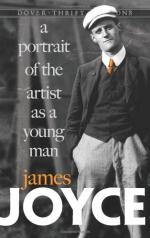They had reached the canal bridge and, turning from their course, went on by the trees. A crude grey light, mirrored in the sluggish water and a smell of wet branches over their heads seemed to war against the course of Stephen’s thought.
—But you have not answered my question, said Lynch. What is art? What is the beauty it expresses?
—That was the first definition I gave you, you sleepy-headed wretch, said Stephen, when I began to try to think out the matter for myself. Do you remember the night? Cranly lost his temper and began to talk about Wicklow bacon.
—I remember, said Lynch. He told us about them flaming fat devils of pigs.
—Art, said Stephen, is the human disposition of sensible or intelligible matter for an esthetic end. You remember the pigs and forget that. You are a distressing pair, you and Cranly.
Lynch made a grimace at the raw grey sky and said:
—If I am to listen to your esthetic philosophy give me at least another cigarette. I don’t care about it. I don’t even care about women. Damn you and damn everything. I want a job of five hundred a year. You can’t get me one.
Stephen handed him the packet of cigarettes. Lynch took the last one that remained, saying simply:
—Proceed!
—Aquinas, said Stephen, says that is beautiful the apprehension of which pleases.
Lynch nodded.
—I remember that, he said, PULCRA SUNT QUAE visa placent.
—He uses the word visa, said Stephen, to cover esthetic apprehensions of all kinds, whether through sight or hearing or through any other avenue of apprehension. This word, though it is vague, is clear enough to keep away good and evil which excite desire and loathing. It means certainly a stasis and not a kinesis. How about the true? It produces also a stasis of the mind. You would not write your name in pencil across the hypotenuse of a right-angled triangle.
—No, said Lynch, give me the hypotenuse of the Venus of Praxiteles.
—Static therefore, said Stephen. Plato, I believe, said that beauty is the splendour of truth. I don’t think that it has a meaning, but the true and the beautiful are akin. Truth is beheld by the intellect which is appeased by the most satisfying relations of the intelligible; beauty is beheld by the imagination which is appeased by the most satisfying relations of the sensible. The first step in the direction of truth is to understand the frame and scope of the intellect itself, to comprehend the act itself of intellection. Aristotle’s entire system of philosophy rests upon his book of psychology and that, I think, rests on his statement that the same attribute cannot at the same time and in the same connexion belong to and not belong to the same subject. The first step in the direction of beauty is to understand the frame and scope of the imagination, to comprehend the act itself of esthetic apprehension. Is that clear?




